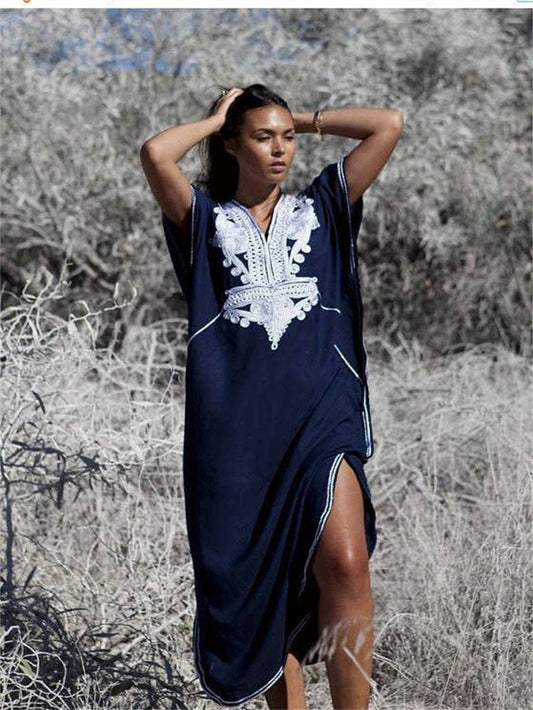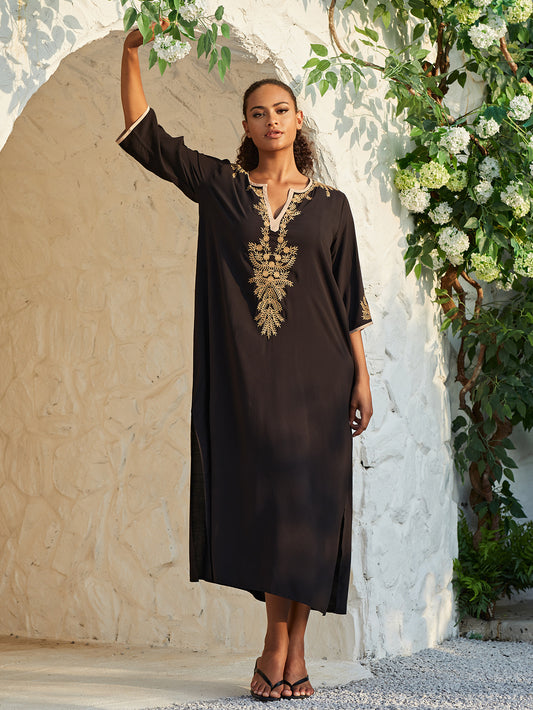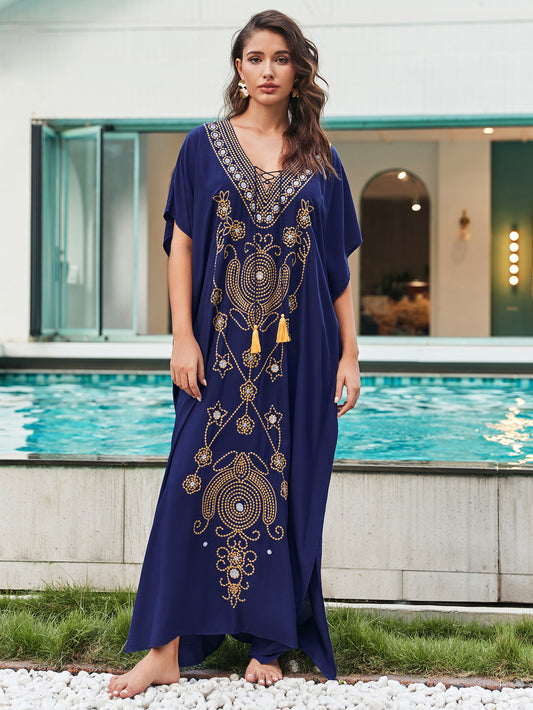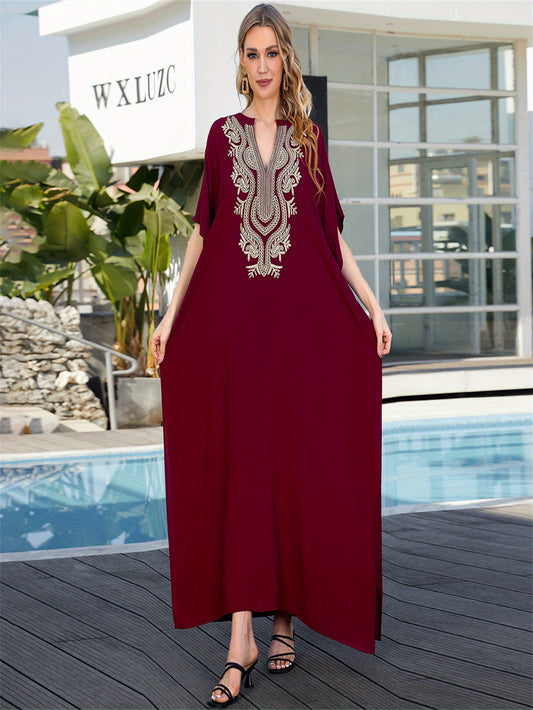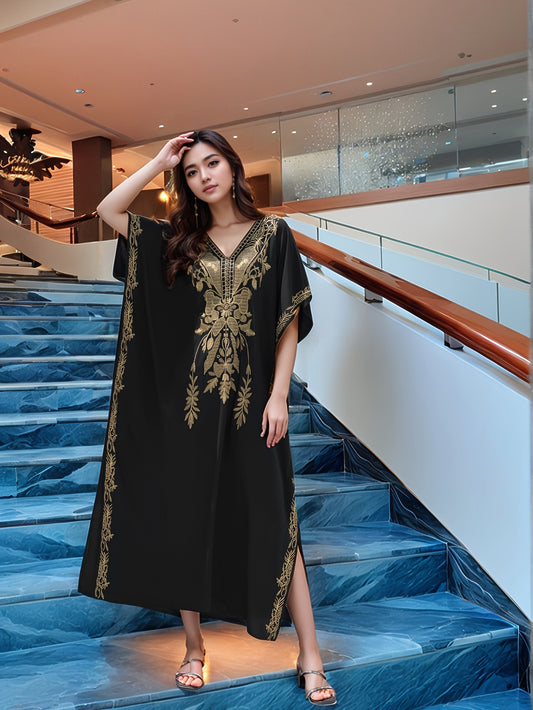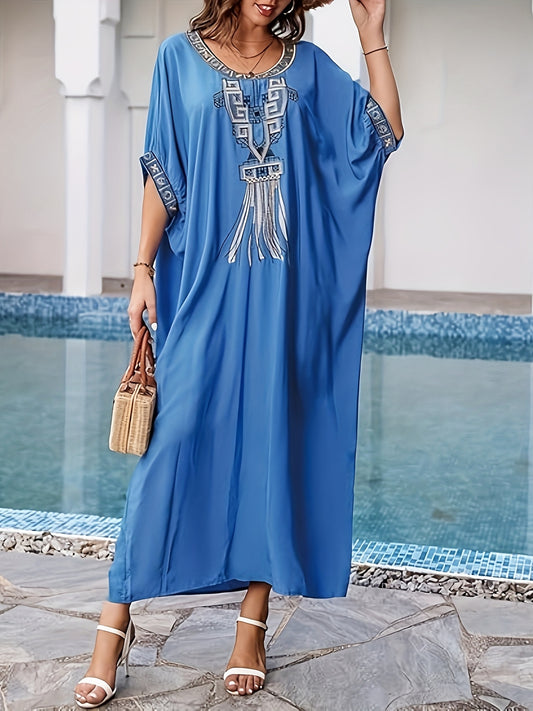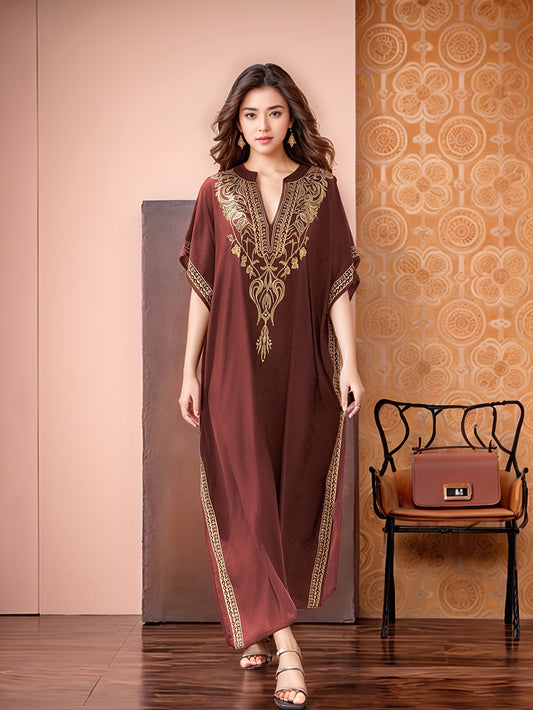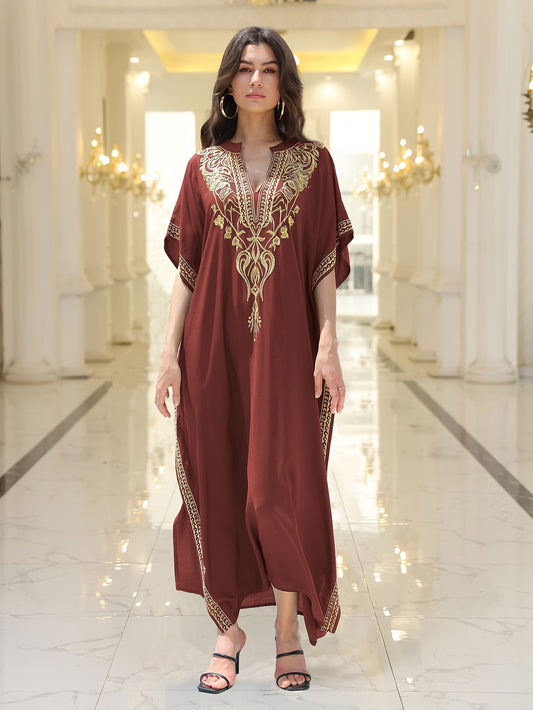About Cotton Kaftan
Cotton Kaftan Collection
The cotton kaftan is one of the most enduring garments in the history of global fashion. Known for its elegance, comfort, and cultural symbolism, the kaftan has traveled across centuries and continents, continually reinventing itself to suit the aesthetics of changing societies. Unlike fleeting trends, the kaftan remains relevant because it is timeless. Made from breathable cotton, it adapts effortlessly to different climates and lifestyles while retaining a graceful silhouette. Today, cotton kaftans are celebrated for their ability to embody tradition, style, and practicality simultaneously.
This article explores the cotton kaftan in depth—its history, fabric processes, cultural symbolism, regional traditions, modern fashion collaborations, sustainability, and continued influence in contemporary wardrobes.
Historical Origins Of The Kaftan
The kaftan originated in Mesopotamia and quickly spread across the Middle East, Persia, and North Africa. Ottoman sultans elevated the kaftan to a garment of prestige, commissioning elaborate versions embroidered with gold thread and adorned with jewels. In Morocco, kaftans became royal attire, worn at weddings and state ceremonies.
As trade routes expanded, the kaftan reached Europe, where it influenced aristocratic fashion. By the 20th century, the garment entered global fashion when designers embraced it for its exotic charm and fluid silhouette. Cotton versions became particularly popular in warmer climates, offering comfort without sacrificing elegance.
Why Cotton Kaftans Remain Essential
Among the many fabrics used for kaftans—silk, velvet, brocade—cotton remains the most versatile. Its advantages include:
-
Breathability: Cotton allows air circulation, making kaftans ideal for hot climates.
-
Softness: Gentle on skin, suitable for all-day wear.
-
Durability: High-quality cotton withstands repeated washes and wear.
-
Versatility: Cotton kaftans range from casual tunics to embellished formal attire.
-
Sustainability: Cotton, particularly organic cotton, is eco-friendlier than many synthetics.
These qualities explain the enduring global demand for cotton kaftans.
Cotton Fabric Processes
The beauty of a cotton kaftan lies not only in its design but in the meticulous processes that bring it to life:
-
Weaving: Cotton fibers are spun into yarns, then woven into fabrics of varying densities. Lightweight weaves create airy kaftans, while denser fabrics add structure.
-
Dyeing: Natural and synthetic dyes bring vibrant colors. Traditional tie-dye or block-print techniques are often used for artisanal kaftans.
-
Embroidery: Regional styles differ—gold thread in Moroccan kaftans, mirror work in South Asian versions, and bead embellishments in African designs.
-
Finishing: Softening, ironing, and detailing ensure that kaftans meet the standards of comfort and elegance expected in modern fashion.
This blend of artistry and technical skill transforms simple cotton fibers into garments of cultural and aesthetic significance.
Regional Styling Traditions
Middle East
Kaftans in the Middle East are associated with ceremonies and celebrations. Embroidered cotton kaftans are worn during Ramadan, Eid, and weddings. Often embellished with gold or silver thread, they balance modesty with luxury.
North Africa
Moroccan cotton kaftans are known for intricate embroidery and flowing silhouettes. In Tunisia and Algeria, kaftans incorporate regional motifs that symbolize heritage. Cotton versions are common for summer festivals and casual occasions.
South Asia
In India and Pakistan, cotton kaftans serve both casual and formal purposes. Hand-embroidered kaftans with sequins or beads are common for festive wear, while printed cotton kaftans function as everyday tunics.
West Africa
While distinct garments like the boubou dominate, kaftan-inspired cotton robes are also significant. Bright colors, bold prints, and wide sleeves reflect cultural pride and communal identity.
Europe
In Europe, cotton kaftans became symbols of bohemian luxury in the 1960s. Today, they are worn as resort wear or styled as minimalist dresses. Italian and French designers often reinterpret the kaftan for modern haute couture.
Western Fashion
Western fashion views the cotton kaftan as an embodiment of leisure. It is common in beach resorts, luxury hotels, and high-end loungewear collections. Celebrities frequently adopt kaftans for red carpets and private events.
Kaftans In Western Fashion History
The 20th century marked a turning point for the kaftan. In the 1960s, Yves Saint Laurent and Halston introduced kaftans into European and American fashion, presenting them as exotic and glamorous. Socialites like Elizabeth Taylor wore kaftans to parties and vacations, cementing the garment’s association with luxury. Cotton kaftans became part of resort fashion, perfect for poolside lounging and summer evenings. Today, their presence in Western wardrobes underscores their timeless global appeal.
Modern Fashion Collaborations
Kaftans have not remained confined to traditional contexts. Luxury and contemporary designers frequently collaborate with artisans to reimagine cotton kaftans:
-
Designer Brands: Global labels incorporate cotton kaftans into summer and resort collections, emphasizing sustainability and elegance.
-
Celebrity Endorsements: Celebrities wear kaftans at festivals, vacations, and even on runways, inspiring their mass popularity.
-
Sustainable Fashion: Brands focused on ethical production highlight cotton kaftans as examples of eco-conscious luxury.
-
Artisan Collaborations: Partnerships with weavers and embroiderers ensure that heritage craftsmanship thrives in modern fashion markets.
These collaborations keep kaftans relevant, showing that they adapt easily to contemporary lifestyles without losing heritage.
Styling Cotton Kaftans
Cotton kaftans can be styled for different occasions:
-
Daywear: Worn with sandals for a chic casual look.
-
Beachwear: Used as swim cover-ups with wide-brimmed hats.
-
Office Wear: Minimalist cotton kaftans with tailored cuts styled with heels.
-
Festivals: Bright printed cotton kaftans accessorized with jewelry.
-
Formal Events: Embroidered cotton kaftans elevated with belts and heels.
The kaftan’s simple silhouette makes it a blank canvas for personal expression.
Cultural And Emotional Symbolism
Kaftans symbolize freedom, identity, and tradition. In the Middle East and North Africa, they represent heritage and celebration. In the West, they evoke individuality and relaxation. Emotionally, cotton kaftans bring comfort, grounding wearers in simplicity while allowing them to feel elegant. Their ability to embody both heritage and modernity explains their universal significance.
Color Psychology In Cotton Kaftans
Colors enhance the meaning of kaftans:
-
White: Symbol of purity and simplicity, often used for summer wear.
-
Blue: Evokes calmness, aligning with coastal lifestyles.
-
Red And Orange: Represent energy and passion, suited for festivals.
-
Earth Tones: Connect to nature, symbolizing grounding and balance.
-
Black: Projects sophistication and authority, perfect for formal kaftans.
By choosing a kaftan in a specific color, women communicate personality, mood, and intention.
Practical Benefits Of Cotton
Cotton remains one of the world’s most trusted fabrics:
-
Moisture Absorption: Keeps wearers cool in heat.
-
Hypoallergenic: Ideal for sensitive skin.
-
Climate Adaptability: Works in both hot and cool weather.
-
Durability: Resists wear and maintains quality with care.
-
Sustainability: Eco-friendlier than many synthetic fabrics.
These attributes strengthen cotton kaftans’ global appeal.
Sustainability And Ethics
Sustainability has become central to modern fashion. Cotton kaftans made from organic fibers reduce environmental impact. Fair-trade initiatives ensure artisans are compensated fairly. Fabulive incorporates sustainability into its kaftan collection, aligning style with responsibility. Customers appreciate knowing their purchases contribute positively to communities and the environment.
Fabulive’s Cotton Kaftan Collection
Fabulive’s cotton kaftan collection represents a harmonious blend of tradition and modernity. Each kaftan is carefully crafted, ensuring comfort, durability, and timeless style. Whether embroidered, printed, or minimalist, Fabulive’s designs meet the needs of women seeking elegance in both casual and formal settings. By focusing on inclusivity, quality, and ethical practices, Fabulive ensures its cotton kaftans remain staples in global wardrobes.
Investment Value
Cotton kaftans provide lasting value. They serve as adaptable garments suitable for diverse occasions while being durable enough to last years. Women often describe kaftans as emotional investments, offering comfort and identity alongside fashion. Their practicality ensures that they remain more than seasonal trends—they are timeless wardrobe essentials.
The Enduring Legacy
The cotton kaftan’s legacy lies in its ability to cross cultural and temporal boundaries. Rooted in Mesopotamian and Ottoman traditions, enriched by African and South Asian artistry, and modernized by global fashion houses, the cotton kaftan continues to thrive. Its universal appeal reflects its adaptability, blending comfort, elegance, and identity. For generations to come, cotton kaftans will remain iconic garments symbolizing both heritage and modernity.
Reviews
-
Olivia Carter, USA: “The cotton kaftan I bought is lightweight and stylish. Perfect for summer days.” ⭐⭐⭐⭐⭐
-
James Thornton, UK: “Elegant yet comfortable. I’ve worn it at home and on holidays.” ⭐⭐⭐⭐
-
Isabella Rossi, Italy: “The embroidery is beautiful. It feels luxurious but practical.” ⭐⭐⭐⭐⭐
-
Hannah Wilson, Canada: “I use mine as lounge wear and beach wear. Excellent quality cotton.” ⭐⭐⭐⭐
-
Sofia Andersen, Denmark: “Minimal yet elegant. This kaftan fits my Scandinavian lifestyle perfectly.” ⭐⭐⭐⭐⭐
-
Amelia Brown, Australia: “The cotton is breathable and ideal for hot weather. I love the design.” ⭐⭐⭐⭐⭐
-
Khalid Al-Mansoori, UAE: “Purchased one for my wife and she adores it. Beautiful craftsmanship.” ⭐⭐⭐⭐
-
Charlotte Green, France: “Classic and timeless. The print is subtle and chic.” ⭐⭐⭐⭐⭐
-
Emily Johnson, USA: “Fabulive’s cotton kaftan is my favorite outfit for casual evenings. Very versatile.” ⭐⭐⭐⭐
-
Ahmed Rahman, Qatar: “It combines tradition with modern style. Excellent investment piece.” ⭐⭐⭐⭐⭐


